
Using position-time graphs and number lines to find displacement and distance traveled.
- Subject:
- Physical Science
- Physics
- Material Type:
- Lesson
- Provider:
- Khan Academy
- Provider Set:
- Khan Academy
- Author:
- Sal Khan
- Date Added:
- 07/15/2021

Using position-time graphs and number lines to find displacement and distance traveled.
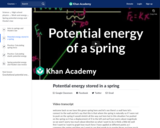
Work needed to compress a spring is the same as the potential energy stored in the compressed spring. Created by Sal Khan.
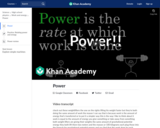
IIII haaaave the powerrrr! Power is the rate at which work is done. Created by David SantoPietro.
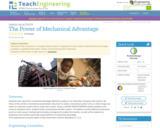
Students learn about the mechanical advantage offered by pulleys in an interactive and game-like manner. By virtue of the activity's mechatronic presentation, they learn to study a mechanical system not as a static image, but rather as a dynamic system that is under their control. Using a LEGO® MINDSTORMS® robotics platform and common hardware items, students build a mechanized elevator system. The ability to control different parameters (such as motor power, testing load and pulley arrangement) enables the teacher, as well as the students, to emphasize and reinforce particular aspects/effects of mechanical advantage.
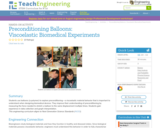
Students use balloons (a polymer) to explore preconditioning a viscoelastic material behavior that is important to understand when designing biomedical devices. They improve their understanding of preconditioning by measuring the force needed to stretch a balloon to the same displacement multiple times. Students gain experience in data collection and graph interpretation.
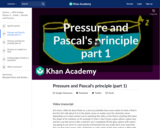
Sal explains the difference between liquids and gasses (both fluids). He then starts a calculation of the work done on a liquid in a U-shaped container. Created by Sal Khan.
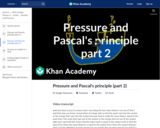
Sal finishes the calculation of work to determine the mechanical advantage in a U-shaped tube. He also explains pressure and Pascal's Principle. Created by Sal Khan.
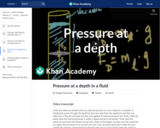
Sal derives the formula to determine the pressure at a specific depth in a fluid. Created by Sal Khan.
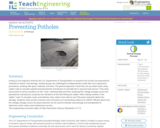
Acting as civil engineers hired by the U.S. Department of Transportation to research how to best use piezoelectric materials to detect road damage, student groups are challenged to independently create their own experiment procedures, working with given materials and tools. The general approach is that they set up model roads using rubber mats to simulate asphalt and piezoelectric transducers to simulate the in-ground road sensors. They drop heavy bolts at various locations on the “road,” collecting data and then analyzing the voltage changes across the piezoelectric transducers caused by the vibrations of the bolt hitting the rubber. After making notches in the rubber “road” to simulate cracks and potholes, they collect more data to see if the piezo elements detect the damage. Students write up their research and conclusions as if presenting evidence to USDOT officials about how the voltage changes across the piezo elements can be used to indicate road damage and extrapolated to determine when roads need maintenance service.
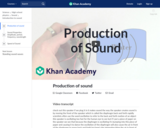
Sound is vibrating air. But how does the air start vibrating? Created by David SantoPietro.

In this video segment from Cyberchase, the CyberSquad breaks down an action into a series of steps in order to program a robot to do what they need it to do.
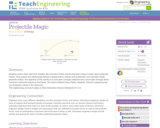
Students watch video clips from October Sky and Harry Potter and the Sorcerer's Stone to learn about projectile motion. They explore the relationships between displacement, velocity and acceleration and calculate simple projectile motion. The objective of this activity is to articulate concepts related to force and motion through direct immersive interaction based on the theme, The Science Behind Harry Potter. Students' interest is piqued by the use of popular culture in the classroom.
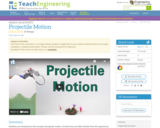
Students are introduced to the concept of projectile motion, of which they are often familiar from life experiences,such as playing sports such as basketball or baseball, even though they may not understand the physics involved. Students use tabletop-sized robots to build projectile throwers and measure motion using sensors. They compute distances and velocities using simple kinematic equations and confirm their results through measurements by hand. To apply the concept, students calculate the necessary speed of an object to reach a certain distance in a hypothetical scenaro: A group of hikers stranded at the bottom of a cliff need food, but rescuers cannot deliver it themselves, so they must devise a way to get the food to the hikers.
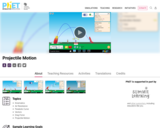
Blast a Buick out of a cannon! Learn about projectile motion by firing various objects. Set the angle, initial speed, and mass. Add air resistance. Make a game out of this simulation by trying to hit a target.
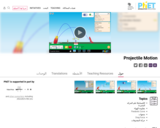
Blast a Buick out of a cannon! Learn about projectile motion by firing various objects. Set the angle, initial speed, and mass. Add air resistance. Make a game out of this simulation by trying to hit a target.
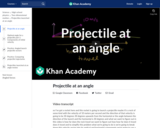
Figuring out the horizontal displacement for a projectile launched at an angle. Created by Sal Khan.
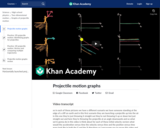
Visualizing position, velocity and acceleration in two-dimensions for projectile motion.

This wiki page documents the Projection Investigation Activity done during San Francisco Unified School District's SLANT workshop on January 29, 2011. Projection information, Julia Marshall's 5 Ways to Integrate, and links are provided, as well as the introductory Improv Activity "Advertising Team" which stretches the imagination to design something for the future. The Projection Investigation Activity begins with research around a scientific theme, then brainstorming and prototyping design ideas around that theme, and finally writing a narrative to present the prototype.
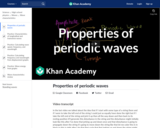
Amplitude, period, frequency and wavelength of periodic waves. How to calculate wave velocity. Created by Sal Khan.
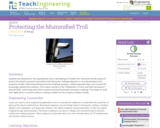
Students are introduced to the (hypothetical) task of developing an invisible (non-intrusive) security system to protect the school's treasured mummified troll! Solving the challenge depends on an understanding of the properties of light. After being introduced to the challenge question, students generate ideas and consider the knowledge required find solutions. They watch a portion of the "Mythbuster's Crimes and Myth-Demeanors" episode ($20), which helps direct their research and learning toward solving the challenge. They begin to study laser applications in security systems, coming to realize the role of lasers in today's society.